
|
Sale 17
Coin Auction
| Lot |
Photo |
Description |
Realized |
Lot 1896 |
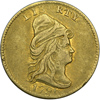 |
$2.50 Capped Bust. 1796. No stars on obverse, B-1, R-4. PCGS graded EF-45. A lovely example of this sought-after issue. The color is a natural hazy gold color on the obverse, more coppery luster on the reverse where the design elements protected the lustrous fields. Struck with adequate force on Liberty, even better on the reverse which is crisp on all but the tail feathers. This is an early die state, with a full and complete lower curl on Liberty, most seen are struck later, after the die was lapped and weakening this curl. There is no trace of the obverse die crack at 9 o'clock. As always, the E of LIBERTY is weakly struck, this letter had the unfortunate location of being directly behind the eagle's large tail, and when these were struck, there simply wasn't enough metal flow to fill in both the tail and the E. Finding a 1796 quarter eagle that is sharply struck is about as easy as locating a 1796 quarter with a full head on the eagle!
Historically speaking, the 1796 quarter eagle is very important. First off, the 1796 quarter eagle is the first coin to employ the heraldic eagle reverse, which would become standard on all silver and gold issues from 1798 to 1807. In addition, this was the first coin struck to reflect the admission of Tennessee into the United States, and the reverse displays 16 stars, one for each of the states then in the union. Curiously, this is the only precious metal coin struck by our country that didn't employ obverse stars, and this didn't occur again until the 1836 Gobrecht dollars were coined. This is also the first year of issue of the denomination, following close on the heals of the 1795 eagle and half eagle.
The dies are thought to have been engraved by Robert Scot, and show hasty preparation. Note how the 6 is squeezed into the drapery lines of Liberty, and the reverse shows unplanned execution as well, with stars planted wherever space allowed above the eagle. For some years the cap on Liberty was thought to be a slaves cap, or Phrygian cap (Liberty cap) of Roman times. A letter from Samuel More, Director of the Mint to Thomas Jefferson on February 14, 1825 seems to settle the matter (see Breen's Encyclopedia, pages 518-19) which states the cap was "taken from life, and considered a model of good taste of the fashion of the time" and was not intended to represent a cap of freedom or slaves cap. Jefferson responded to Moore's letter stating that Liberty had never been a slave, and therefore a slaves cap would not have been proper. In following years the cap disappeared from Liberty on gold coinage in 1834, silver (other than the dollar) in the late 1830s, where the cap moved to the pole until 1891. The cap returned on the Morgan silver dollar in 1878 and on half dollars again in 1916, perhaps reflecting the "good taste" of the fashion of later periods as well.
A classic example of this rare coin which boasts a mintage of a scant 963, of which perhaps ten percent survive most of which are in circulated grades. An impressive example for the true numismatist, and one that has been an expensive rarity for over 100 years (PCGS # 7645) .
Estimated Value $30,000 - 40,000.
From the Benson collection and purchased from an unknown source (probably Ira S. Reed or James MacCallister) around 1945 for $500.
View details and enlarged photos
Check results on similar lots
| Realized
$50,600 |
Lot 1897 |
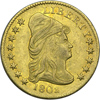 |
$2.50 Capped Bust. 1802, B-1 or 3, R-4. PCGS graded AU-58. This is the more common die pairing of the year, and it is quickly identifiable by a thin die line connecting the second feather down on the right wing to the upper part of the first A in AMERICA. Another heavy die line extends from near the top of the shield left into the wing towards the D of UNITED. Research has shown (Mark Borckardt and the Harry Bass Foundation) that the so called overdate does not exist on quarter eagles, and perhaps entered the numismatic mainstream due to the commonness of the 1802/1 dollars and half eagles. The PCGS holder labels the date as 1802/'1', in keeping with the current Guide Book, but departing from Breen's Encyclopedia and others as mentioned. There is simply no trace of an undertype 1 under the 2. In the 1960s Breen Monograph on the series, both the Breen-1 and Breen-3 varieties are apparently the same die pairing as further research has shown.
As to the strike, we note minor weakness at the centers, as often seen, with the curls around Liberty's ear weak, and similarly weak on the eagle's head and neck with few feathers showing definition, elsewhere the strike is sharp. The coin is toned a rich coppery gold color over substantial luster. Barely circulated, the upper devices show traces of wear, and the fields show very few handling marks. There are no traces of adjustment marks which we could find. Perfect for the type, date or variety collector who demands a quality example. PCGS has graded 8 this high, with 15 graded higher of the date (PCGS # 7650) .
Estimated Value $6,000 - 7,000.
From the Benson collection and purchased from Ira S. Reed on September 22, 1944 as "extremely fine" for $65.00.
View details and enlarged photos
Check results on similar lots
| Realized
$20,125 |
Lot 1898 |
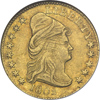 |
$2.50 Capped Bust. 1802. NGC graded AU-58. Sharp on the reverse for the most part, with minimal weakness on the eagle's neck and chest as expected for this date. The obverse is a bit weaker because of adjustment marks which present near the center of Liberty. There are traces of luster in the protected areas and the fields show some antique coppery toning.
Estimated Value $9,000 - 9,500.
View details and enlarged photos
| Unsold |
Lot 1899 |
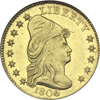 |
$2.50 Capped Bust. 1806, 6 over 4, B-1. Stars 8 X 5. NGC graded MS-64. Here is a monumental example of this scarce die variety which is apparently the very finest known of the variety. The surfaces are well preserved and we note the original mirror like fields remain intact in the protect areas where no handling or friction has disturbed this delicate surface area. The color is a rich golden yellow hue, and no toning is seen. There are minor and faint adjustment marks down Liberty's cap and head on the obverse. As usual the reverse is not fully struck at the central area, with parts of the shield, neck and wing lacking some definition.
NGC has graded only 1 coin this high, this specimen, and one other as MS-63 below, with a few more below the choice grade. PCGS has graded two coins as high as MS-61, with none higher. Thus, we can logically conclude that this particular example is very likely the finest known of the variety. A faint die crack connects stars three to eight, and the tops of LIBERTY. A splendid opportunity for the advanced numismatist.
Estimated Value $75,000-UP.
View details and enlarged photos
| Realized
$71,875 |
Lot 1900 |
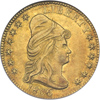 |
$2.50 Capped Bust. 1806, 6 over 5, Breen-2. Stars 7 X 6. NGC graded MS-63. Here is the finest graded example of this rare date at both NGC and PCGS. The surfaces show just a faint scattering of ticks from handling over the two centuries, and most of the luster is present in the protected areas. We note that the surfaces show no adjustment marks, and are therefore more pleasing to the eye. Further, the reported mintage of this date is a scant 480 coins, of which the combined NGC and PCGS population reports show 19 graded. Of these 19 surviving coins, this particular example is the finest one seen, and most likely the very finest known! The strike is very sharp too, without the usual weakness seen at the central reverse, and the neck feathers and head are visible.
We note some delicate coppery toning around the obverse periphery, and a tiny die crack connects the interior points of stars five to seven, then another crack is noted from the upper point of star seven along the tops of LIBE. It is interesting to note that the reverse die was used to coin quarter eagles of 1805 B-1, 1806 B-1, 1806 B-2 (the present variety), 1807 B-1 and then the same reverse was used to coin the common 1807 JR-1 dimes. Average die life for the period was 11,000 strikes (or coins) before the die was normally cracked or worn enough to be replaced. This particular reverse die lasted for 175,000 strikes, and was only retired as the reverse design was replaced by the new John Reich Capped bust in 1808 on gold coins and in 1809 on dimes. This 1806/5 Capped Bust to right quarter eagle die pairing or die marriage is certainly the rarest of the five different combinations listed above.
One further note, this particular obverse die was used to also coin 1805 quarter eagles and was later overdated to the 1806, 6 over 5. Therefore, as both the obverse and reverse dies were used to coin 1805 quarter eagles, this is the identical die pairing used in 1805 and the only change being the overdate! Hence the 1805 quarter eagle is therefore the exact same die variety as this 1806, 6 over 5! This claim can doubtless be made by just a few examples in American numismatics at most.
Estimated Value $115,000 - 135,000.
View details and enlarged photos
| Unsold |
Lot 1901 |
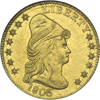 |
$2.50 Capped Bust. 1806, 6 over 5. NGC graded MS-61. An extremely rare coin with a mintage of a scant 480 pieces, and obviously few were saved. This particular example is well struck with good curls on Liberty and a full quotient of feathers on the eagle. Even the shield lines are present, although a few horizontal ones are slightly weak. There are a few minor adjustment marks on the obverse, some near Liberty's temple, others by the date. The fields and surfaces are clean for the grade, and ample luster resides in the fields. NGC has graded 9 examples in all, with this one the sole MS-61, and 3 others are noted higher. A fantastic rarity that belongs in a connoisseurs collection.
Estimated Value $55,000 - 65,000.
View details and enlarged photos
| Unsold |
Lot 1902 |
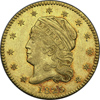 |
$2.50 Capped Head. 1825, Breen-1, Rarity-4. PCGS graded AU-55. A rare date that is seldom offered at all, especially in such high grade. This particular one boasts desirable coppery gold toning around the devices, slightly prooflike fields and a strong strike on both sides. Examination will note that the fields have a generous scattering of handling marks, none by themselves problematic, but collectively worth noting. Identifiable by a small tick on the lower left point of the sixth star, and another small field nick behind the back of Liberty's cap between the ninth and tenth stars. Mintages stalled at 4,434 for the year, and most of these were melted or lost. Perhaps 100 exist today, most in circulated grades well below the grade of this example (PCGS # 7664) .
Estimated Value $5,000 - 6,000.
From the Benson collection and purchased from Barney Bluestone on November 13, 1944 for $100 as "practically uncirculated".
View details and enlarged photos
Check results on similar lots
| Realized
$8,913 |
Lot 1903 |
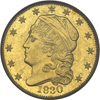 |
$2.50 Capped Head. 1830. PCGS graded MS-63. An extremely rare issue in any grade, and especially so in choice grades! Virtually the entire mintage of these early quarter eagles were melted as their melt value increased above their stated value. Naturally, hoarders gathered up all they could find and melted them for a tidy profit, leaving very few for todays numismatists to collect. Here is a particularly nice coin, with well struck devices and plenty of luster. PCGS has graded just 7 as MS-63, with 3 above as MS-64 and 5 at the top as MS-65 (PCGS # 7670) .
Estimated Value $12,000 - 14,000.
View details and enlarged photos
Check results on similar lots
| Realized
$16,675 |
Lot 1904 |
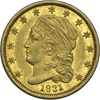 |
$2.50 Capped Head. 1831, Breen-1, Rarity-4. PCGS graded AU-55. Only a single die pairing known of this date, the reverse shows a recut U of UNITED and I of AMERICA. Hazy gold toning on both sides, the fields slightly prooflike but remnants are only present near the devices. Fully struck by the dies, and a rare type coin. Mintage of 4,520, of which perhaps 100 or so survive. A showpiece for an advanced collection (PCGS # 7671) .
Estimated Value $5,500 - 6,000.
From the Benson collection and purchased from Ira S. Reed's Auction of December 2, 1944, lot 867, at $42.50.
View details and enlarged photos
Check results on similar lots
| Realized
$8,338 |
Lot 1905 |
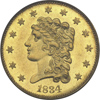 |
$2.50 Classic Head. 1834. No motto. PCGS graded MS-64. Slightly prooflike fields on both the obverse and reverse, and very sharply struck. Light yellow gold in color and very close to a gem grade. Perfect for the type collector who needs a high end example for their set (PCGS # 7692) .
Estimated Value $8,500 - 9,500.
View details and enlarged photos
Check results on similar lots
| Realized
$8,050 |
Lot 1906 |
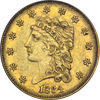 |
$2.50 Classic Head. 1834. No motto. PCGS graded AU-50. Here is a lovely example of this common type coin that was put away and left untouched for decades. Natural appearing surfaces and color on both sides, and totally problem free (PCGS # 7692) .
Estimated Value $450 - 500.
From the Benson collection and purchased from Ward on April 1944, at $6.25 as "uncirculated".
View details and enlarged photos
Check results on similar lots
| Realized
$863 |
Lot 1907 |
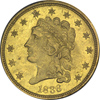 |
$2.50 Classic Head. 1836. Script 8. PCGS graded MS-64 HW Bass Jr. Co. A breathtaking example and virtually as struck. A splendid example for both the date, type and variety. Loaded with frosty mint luster on both sides, this beauty exhibits medium golden-orange color with a natural greenish tint (PCGS # 7694) .
Estimated Value $7,000-UP.
From the Harry W. Bass, Jr. Coll. Part II, lot 290. Formerly from Hank Rogers.
View details and enlarged photos
Check results on similar lots
| Realized
$9,775 |
Lot 1908 |
|
$2.50 Classic Head. 1836. Block 8. VF-20. Decent color and surfaces, the only marks worth mentioning are some light scrapes below the left wing tip.
Estimated Value $200 - 250.
From the Benson collection and purchased from Ira S. Reed on February 8, 1944, at $5.00.
View details
| Realized
$311 |
Lot 1909 |
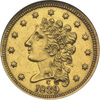 |
$2.50 Classic Head. 1839-C. ANACS graded MS-60. Slightly prooflike on the obverse, and the delicate mirror surfaces show a few ticks from handling. Apparently coined by a rusted die, with some evidence noted on Liberty's cheek. Identifiable by a short series of marks between the first star and Liberty's lower neck. Fairly sharp, but a trace of weakness is present on the high points. Rare, and very difficult to locate in full mint state grades.
Estimated Value $13,000 - 15,000.
View details and enlarged photos
| Realized
$15,525 |
|
|